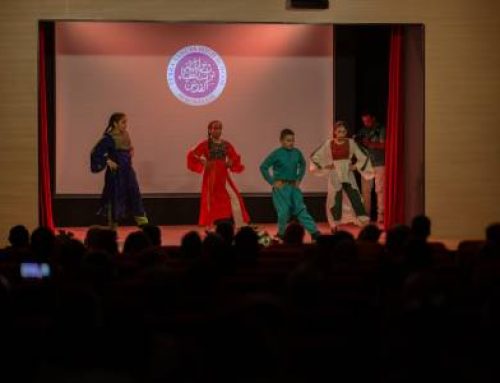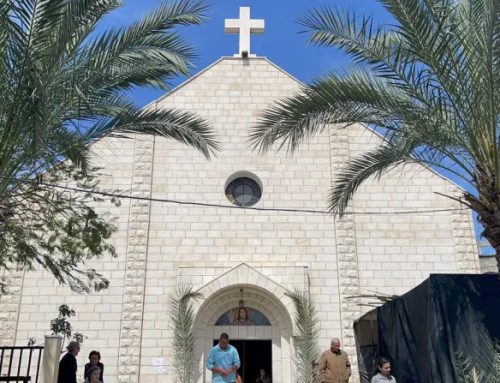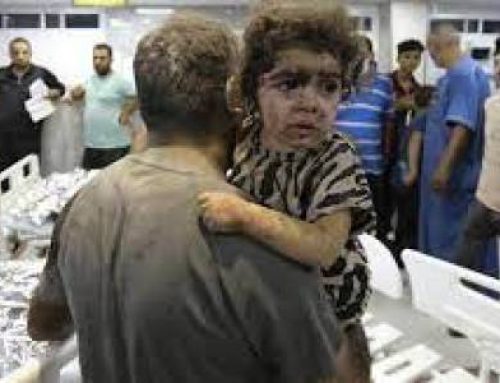Relentless violence hurts, haunts children on embattled West Bank. BETHLEHEM, WEST BANK — Viveca Hazboun has dark circles under eyes. She isn’t getting enough sleep. By Alexa Smith
BETHLEHEM, WEST BANK — Viveca Hazboun has dark circles under eyes.
She isn’t getting enough sleep. And she’s more than a little depressed. Her therapy schedule is so overbooked that she talks with some clients by phone, an unorthodox practice for a psychiatrist.
Bt her caseload, and her circumstances, are far from orthodox.
Hazboun, a Palestinian, is the only certified child psychiatrist on the West Bank. Right now she has her hands full, with bed-wetters, phobics and suicidal thinkers, and of course with their concerned parents, who aren’t functioning well themselves after a full year of the worst violence to hit the West Bank in decades. Meanwhile the Israeli army continues shelling tiny West Bank towns and assassinating suspected terrorists in crowded downtown areas.
” don’t know why you journalists don’t get it,” one man here says. The Israeli army is shelling the civilian population.
Yes, he admits, there are shooters among Palestinians, too, and organized cells of opposition that people are reluctant to discuss. Yet towns full of non-combatants are being besieged by a modern army, month after month.
Adding to Hazboun’s caseload.
“People are really afraid to move,” she says, noting that she has grounded her own three kids, who live with her in an apartment in Jerusalem, where Palestinian suicide bombers are operating again. “I’ve just said, ‘No, you can’t go to McDonald’s on Ben Yehuda (a main thoroughfare in Jewish Jerusalem), and you can’t go here, and you can’t go there. Yesterday I went out and bought videos so they can stay home.”
That is a typical tactic among Palestinian parents today. They are trying to keep their children safe in a world that isn’t.
Any elementary school child on the street here — or in the nearby shell-shocked towns of Beit Jala and Beit Sahour — can tell stories about nights spent in dimly lighted basements while the tiny stone houses above are blasted to rubble. An Israeli military base sits adjacent to Beit Sahour — another highly conflicted spot.
Kids don’t loiter on the way home from school. They know about schoolchildren killed by what the Israelis call random fire. Many Palestinian children can call the names of the dead. They might mention Mo’iyad Jawarish, who was found in the street — shot in the head — book bag still slung over his shoulder. Or Mohammed Abdullah, a youngster who was killed by Israeli snipers as his father tried futilely to protect him; news cameras captured the tragic death and showed that neither Palestinian was armed.
The list of innocent victims is long and growing longer.
Hazboun has personal knowledge of many. She treated a young mother whose son lost an arm to a sniper shortly after he stepped outside the family’s house to get a better look at a cement mixer. Another youngster, insensible with fear,was carried to her Child Guidance and Training Center in Bethlehem after a bullet passed through a central room of her home, a place her mother had told her would be “safe.”
Three weeks ago, two brothers, ages 8 and 10, were killed on a Nablus street where they were waiting for their father to pick them up from summer camp. A helicopter gunship got there first, shelling a downtown office building that Israeli Prime Minister Ariel Sharon said contained offices of the terrorist organization, Hamas. Sharon, who calls his policy “active self-defense,” says Israel will continue to target people thought to be planning terrorist attacks, even, apparently, where civilians are threatened.
In the winter months, Beit Jala, Beit Sahour and a refugee camp on the outskirts of Bethlehem were shelled frequently, on an irregular schedule that kept grown-ups and children on edge. Charlie Haddad, the principal of the Dar-Alkalima School (a Lutheran institution whose name in English is “The House of the Word”) in Bethlehem,says: “It became a daily drill. … And there is a lot of resentment, especially if you know what life could be like, if you know what it feels like to be fine and safe.”
“ine and safe” is not how the Palestinian kids describe themselves.
For example, 6-year-old Tareq Zoughbi, of Bethlehem, drew a picture for his dad of a “great, big man with a small heart” ordering soldiers to kill a child identified as sniper victim Mohammed Abdullah.
Tareq’s father, Zoughbi Zoughbi, is a prominent mediator who openly talks about politics at home — but even he was shocked by the drawing. “I am really worried about the coming days — and not just the economics,” he says, referring to the violence-related collapse of the tourism industry. “(I’m concerned about) the psychology of our children. They’re witnessing death, killing, kidnapping and shooting every day.”
Zoughbi’s has a 5-year-old who dreams about soldiers attacking his school and hurting his sister. He says even the youngest of his brood ask to watch the news before cartoons in the morning:
“They’ll wake me up with a kiss on the cheek and say, ‘I’d like to see the news.’ It is really a situation we need a psychiatrist to find a solution for.
But the violence stymies psychiatrists, too.
“It is like being a little child who is drowning in a swimming pool, and you see and adult and think he will save you. But instead, he pushes your head under water,” says Hazboun, the child therapist. “This is how I feel, and I’m a psychiatrist. So imagine how people feel who are living in a refugee camp without any training in trauma or stress.”
And what does Hazboun tell her young clients?
“I tell them they need to feel pride in their capacity to face this pain. What is happening is scary. It is troublesome. It is dangerous. And it is OK to be scared,” says Hazboun, adding that she also reminds them to listen to their teachers and parents. “I say to them that they should be proud they are able to withstand this anxiety and stress …(that) they are still functioning, under duress.”
Teachers say that, while the kids may be functioning, they are also angrier. More dirty words get scrawled on schoolyard walls. There is more pushing and fighting in the halls. Homework doesn’t get done, sometimes because the electricity is out, sometimes because it is hard to concentrate when shells are exploding outside. Grades are dropping.
And because kids get tired of being cooped up at home, the solution becomes a problem.
“They don’t go anyplace,” schoolteacher Mervat Abu-Kula says of her three children. Her house in Beit Jala is in the line of fire of tanks deployed to Gilo, a Jewish settlement that became a target of Palestinian gunmen last winter. “They go from school to the house, and from the house to the school. They study at home … because I am afraid something will happen if they are out in the streets.
“It is like they are in a prison. They’re fighting with one another, fighting with me. Because they have no place to go and nothing to do.”
Abu-Kula says the army is indiscriminate — unable to directly target gunmen. “When you see the bullets …I don’t know how to say this,” she says, searching for the English words, “enter the house near you, or breaking the windows, you have a bad feeling.
“You are very upset, nervous. … You feel like you are inside a war, but it is a war that is not equal between forces; just from one side. And the Jewish side is shooting and shooting and shooting.”
Bethlehem merchant Sameer Mitri, 39, says his business has collapsed since tourists stopped coming almost a year ago. “If you don’t work here, you don’t eat,” he says. “There is no disability. People are nervous.”
Mitri says he can’t afford to buy the 10 pounds of meat his kids normally consume in a week, so he buys a half-pound only. Last Christmas, he says, there were no gifts: “The bigger kids, they understood. We are buying them clothes, buying them food.”
It has become impossible to protect the children from the violence all around them.
Hazboun says surviving is a matter of embodying the Arabic term samedoon, which in her translation means “those who withstood” or those who hung in there.”
“I think that is what these people are … samedoon, she says. “We have to let these kids who are terrified be proud of their fear, be proud that they have handled it. We go around every day doing our business. We know it is not normal. People should take pride that they are surviving, maintaining something. There’s nothing phony about this.”
But it takes a toll.
Even for Palestinians who’ve survived the seemingly relentless conflict since Israel was established in 1948, this violence is extreme, more intense even than the Intifada that erupted in 1987 and galvanized Palestinian opposition to the Israeli occupation of the West Bank and Gaza.
“It is not like 1987. The context is changing,” says the Rev. Mitri Raheb, no stranger to turmoil, whose mother took him as a child to the Church of the Nativity when the Israelis shelled Bethlehem in 1948.
In the 1987 Intifada, Raheb points out, Israeli soldiers occupied Palestinian towns — and were forced to look into the eyes of young stone-throwers who wanted them to leave. Today, he says, there is no eye contact, no human encounter.
“Israelis now don’t feel the pain like Palestinians,” he says. “Before, soldiers had to walk through the narrow streets in Gaza, and they were able to feel what it was like: what it means (to know) that you can be hurt. Nowadays they use Apache helicopters. This war, for them, is becoming like a computer game. And they cannot be directly hurt like us.”
Asked about the Palestinians, he says, “I’ve never seen so many depressed people.”
In all there are eight psychiatrists on the West Bank, but there is only one psychiatric hospital, in Bethlehem. It does not admit children. Before the outbreak of this Intifada, Palestinian kids were treated in a children’s hospital in Jerusalem, but that isn’t often possible now. And very few Palestinians on the economically beleaguered West Bank have enough money to foot a hospital bill.
So deeply traumatized kids are kept at home, something Hazboun calls “ridiculous.” That’s why she’s trying to raise money to build a children’s facility on the West Bank.
“They need intensive treatment. They need safe treatment. And we don’t have that in Palestine. “Hazboun, the only Christian psychiatrist and the only female psychiatrist on the West Bank, has a hard time getting to her patients. It isn’t always easy to travel from Jerusalem to her clinic in Bethlehem. When the road was closed one day last fall, she had to run for the border — frantic that the Israelis might open fire (although they did not), and dodging rocks thrown by Palestinians. She held her briefcase over her head in defense.
“I’d like to be able to deliver psychiatric care to patients at this point,” she says. “I’d like to be able to reach people who cannot move to get it. And I’d like to feel safe doing it.”
But no one gets to feel safe.
Abu-Kula, sitting in her Beit Jala house, laments: “We want peace. I discuss violence with the children, tell them not to use violence. There are too many people dead in this Intifada. We don’t want any more dead, Palestinian or Jewish. … I’m very, very tired. We’re working under pressure at the school to take care of the children. I don’t let my own children out of the house; outside there may be shooting.
“What can I do? My health is affected this time. I have headaches. My stomach hurts when I hear the shooting. It is nerves.”
No one, it seems, is immune to “nerves.”
Twenty-something Ely Nastas of Beit Jala was hired recently as a social worker at the Dar-Alkalima School. It is her job to listen to kids who are upset by the past year’s violence.
“Lots of the kids are afraid when there is no electricity. They don’t like the dark,” she says, referring to power outages caused by the shelling. She says she doesn’t like it much either.
“In our house, we go to the basement and sleep on the floor, all in the same room, when the shooting comes close,” says Nastas. “This is hard for us, the big people. So what about the children?”





